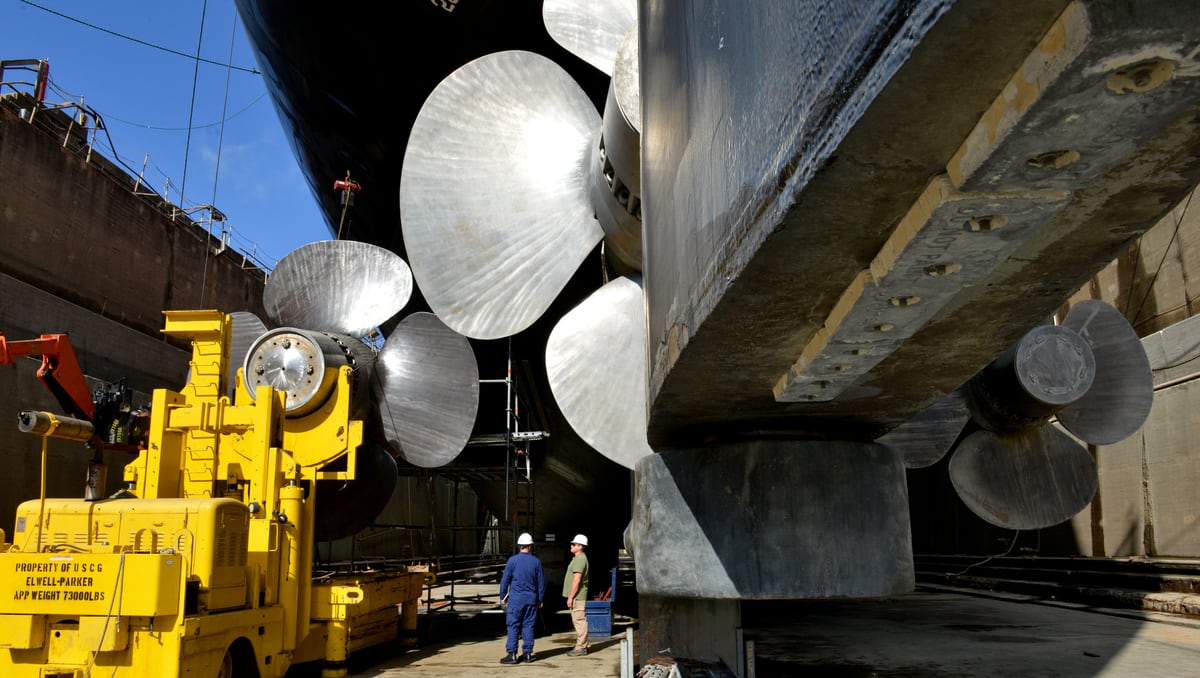The crew of the Coast Guard’s last heavy icebreaker battled a nighttime Feb. 10 blaze for almost two hours before it was extinguished, officials announced Thursday.
The fire erupted in the Polar Star’s garbage incinerator room about 650 miles north of McMurdo Sound, Antarctica.
“It’s always a serious matter whenever a shipboard fire breaks out at sea, and it’s even more concerning when that ship is in one of the most remote places on Earth,” said Vice Adm. Linda Fagan, commander of the U.S. Coast Guard’s Pacific Area, in a written statement emailed to Navy Times.
“The crew of the Polar Star did an outstanding job — their expert response and determination ensured the safety of everyone aboard.”
No one was injured and the cause of the blaze remains under investigation but the fire was another mechanical woe stacked atop an aging breaker that’s annually tasked to perform its part in Operation Deep Freeze, a mission by the Air Force, Navy, Army and National Guard to support the National Science Foundation’s Antarctic operations.
After sailing from its Seattle homeport on Nov. 27, the Polar Star began crunching a channel through 17 miles of ice measured at 6- to 10-feet thick to McMurdo Station, the main logistics hub for U.S. personnel in Antarctica, including researchers at Amundsen-Scott South Pole Station and remote field camps.
On Jan. 30, the icebreaker escorted the container ship Ocean Giant, toting 500 containers loaded with 10 million pounds of supplies, to McMurdo Station.
The cutter refueled and 11 days later, the incinerator room burst into flames.
While the crew contained the fire damage to the incinerator housing, the water used to cool the nearby exhaust pipe flowed into several electrical systems and the insulation.
Officials vowed to have the repairs completed before next year’s 11,200-mile journey to the bottom of the world. When the Polar Star isn’t at sea for Operation Deep Freeze, it’s in dry dock, undergoing repairs.
“Unfortunately, there have been a number of engineering casualties and other problems in recent years. We’re talking about a 43-year-old ship,” said Coast Guard spokesman Senior Chief Public Affairs Specialist Nyx Cangemi.
“Age and the importance of the mission, Operation Deep Freeze, mean that the Polar Star spends much of its time away from McMurdo Station getting repaired."

Cangemi told Navy Times that the only problem for the crew is that they can’t burn their trash on their way home from a port call in New Zealand. He praised the “time and the dedication they show to keep that ship going.”
While sailing to Antarctica, the crew fixed one of the electrical systems that began to smoke, damaging a switchboard. Two of the cutter’s evaporators that make drinking water failed.
A leak also sprang from the shaft that drives one of the ship’s screws.
After parts arrived during a port call in Wellington, New Zealand, the crew fixed the electrical wires and the evaporator system but they couldn’t resume icebreaking operations until scuba divers braved the frigid water to fix a seal around the shaft.
A hyperbaric chamber loaned to the Coasties by the U.S. Navy allowed them to make the emergency repairs and inspect the hull at sea.
While breaking ice, all power in the ship cut off and the crew had to spend nine hours shutting down the power plant and rebooting the electrical system to mend that, officials added.
If the crew couldn’t repair the ship, it might’ve become an international embarrassment. Although the Coast Guard also maintains a medium breaker, Healy, for North Pole patrols, the United States has no self-rescue capabilities for Antarctic ice.
Another nation, maybe a rival such as Russia, would have to rescue the Coast Guard crew. Moscow boasts a fleet of at least 40 icebreakers and plans to add even larger vessels to the frozen flotilla.
Commissioned in 1976, the Polar Star is 13 years past its intended service life.
A slightly younger sister, Polar Sea, got knocked out of service in 2010, when pistons in five of the six main diesel engines welded to their sleeves.
In early 2017, it was marked by the Coast Guard as a “parts donor” — which means crews began cannibalizing it to keep the Polar Star running.
On Feb. 14, President Donald J. Trump signed a bill that earmarked $655 million for the design and construction of a new icebreaker, plus $20 million for materials necessary to start on a second vessel.
But Coast Guard officials say that they need six new Polar Security Cutters to patrol the Arctic and Antarctic regions.
“While we focus our efforts on creating a peaceful and collaborative environment in the Arctic, we’re also responding to the impacts of increased competition in this strategically important region,” said Coast Guard Commandant Adm. Karl Schultz in a prepared statement.
“Our continued presence will enable us to reinforce positive opportunities and mitigate negative consequences today and tomorrow.”
Prine came to Navy Times after stints at the San Diego Union-Tribune and Pittsburgh Tribune-Review. He served in the Marine Corps and the Pennsylvania Army National Guard. His awards include the Joseph Galloway Award for Distinguished Reporting on the military, a first prize from Investigative Reporters & Editors and the Combat Infantryman Badge.





